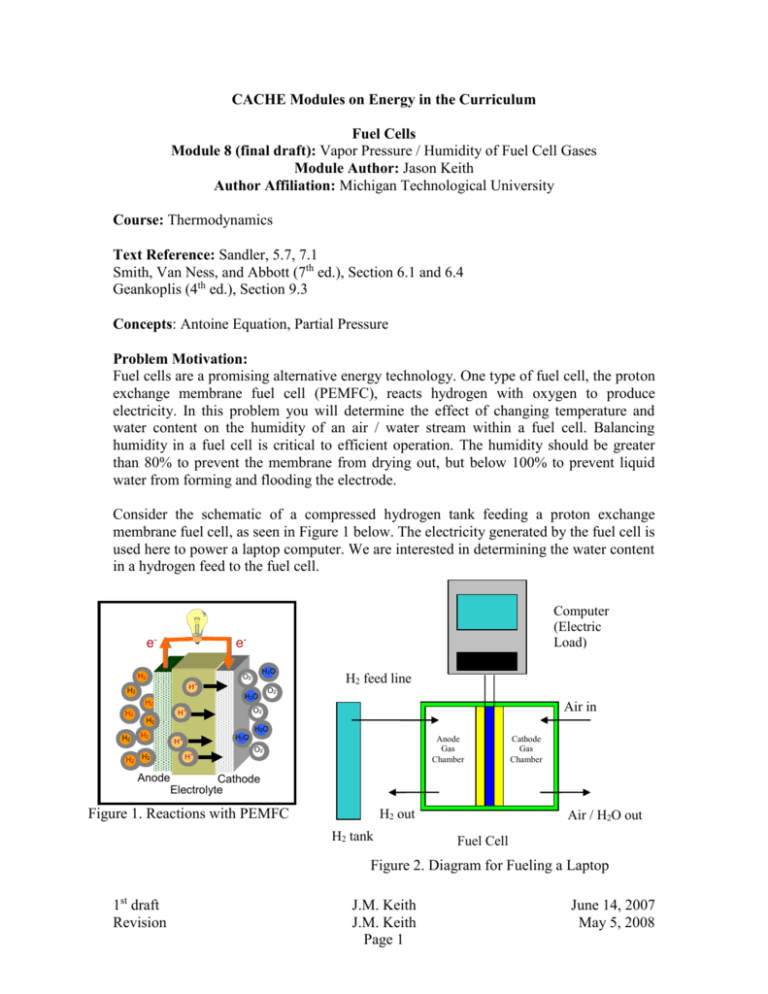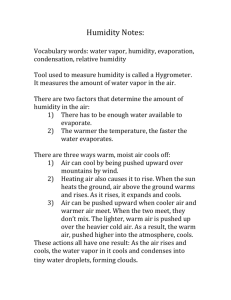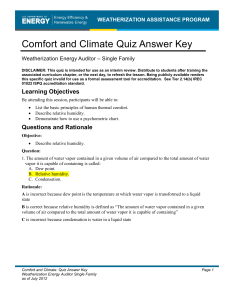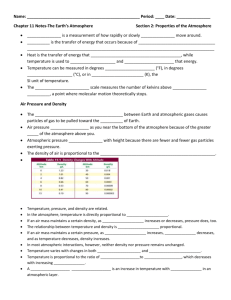Module 9: Vapor Pressure / Humidity for Fuel Cell Gases
advertisement

CACHE Modules on Energy in the Curriculum Fuel Cells Module 8 (final draft): Vapor Pressure / Humidity of Fuel Cell Gases Module Author: Jason Keith Author Affiliation: Michigan Technological University Course: Thermodynamics Text Reference: Sandler, 5.7, 7.1 Smith, Van Ness, and Abbott (7th ed.), Section 6.1 and 6.4 Geankoplis (4th ed.), Section 9.3 Concepts: Antoine Equation, Partial Pressure Problem Motivation: Fuel cells are a promising alternative energy technology. One type of fuel cell, the proton exchange membrane fuel cell (PEMFC), reacts hydrogen with oxygen to produce electricity. In this problem you will determine the effect of changing temperature and water content on the humidity of an air / water stream within a fuel cell. Balancing humidity in a fuel cell is critical to efficient operation. The humidity should be greater than 80% to prevent the membrane from drying out, but below 100% to prevent liquid water from forming and flooding the electrode. Consider the schematic of a compressed hydrogen tank feeding a proton exchange membrane fuel cell, as seen in Figure 1 below. The electricity generated by the fuel cell is used here to power a laptop computer. We are interested in determining the water content in a hydrogen feed to the fuel cell. Computer (Electric Load) e- eH2 H2O O2 H+ H2 H2O H2 Air in O2 H+ H2 H2 feed line O2 H2 H2 H2 H2 H2 H2O H2O H+ + Anode Gas Chamber O2 H Cathode Gas Chamber Anode Cathode Electrolyte Figure 1. Reactions with PEMFC H2 out H2 tank Air / H2O out Fuel Cell Figure 2. Diagram for Fueling a Laptop 1st draft Revision J.M. Keith J.M. Keith Page 1 June 14, 2007 May 5, 2008 Problem Information Example Problem Statement: In this example problem you will use the concept of vapor pressure to help you determine the humidity of an air / water vapor mixture. On a cool spring morning with a rainy forecast, the temperature is 67 oF, with a relative humidity of 79%. What is the temperature in degrees Celcius, saturated vapor pressure in kPa, partial pressure of water vapor in kPa, and humidity in kg H2O / kg dry air? Assume an atmospheric pressure of 1 bar. Note that 1 bar = 100 kPa. Example Problem Solution: Step 1) We can convert the temperature to degrees Celcius using: T(oC) = (T(oF) – 32) x 5/9. Thus, 67 oF is equal to 19.4 oC. Step 2) The saturated vapor pressure of water in kPa can be determined using the Antoine Equation (Equation 6.76 on page 223 of the 7th edition of Smith, Van Ness, and Abbott), log 10 PSAT A B T C where, PSAT = vapor pressure, mm Hg A = 8.10765 B = 1750.286 C = 235 T = temperature, °C Substituting into this equation gives PSAT = 16.9 mm Hg. Recognizing that there 101.325 kPa = 760 mm Hg, we have PSAT = 2.26 kPa. Step 3) The relative humidity is the ratio of partial water pressure (PW) and the total vapor pressure (PSAT), (given by Equation 9.3-4 on page 566 in the 4th edition of Geankoplis) PW PSAT Thus, PW = (0.79)(2.26 kPa) = 1.79 kPa. Step 4) Finally, the humidity is defined as the ratio of the mass of water vapor to the mass of dry air. The molar ratio can be written using the ideal gas law, and then with use of the molecular weights of the gases, to give the mass ratio (given by Equation 9.3-1 on page 565 of the 4th edition of Geankoplis) as: 1st draft Revision J.M. Keith J.M. Keith Page 2 June 14, 2007 May 5, 2008 H 18.02 PW 28.97 P PW With P = 100 kPa, we have H = 0.0113 kg H2O / kg dry air. Summary. In this module we have related vapor pressure and humidity of an air / water vapor mixture entering a fuel cell. The homework problem will have more specific application to fuel cell operation. 1st draft Revision J.M. Keith J.M. Keith Page 3 June 14, 2007 May 5, 2008 Home Problem Statement: You have an air /water mixture entering a fuel cell at a temperature of 20 oC, a relative humidity of 70%, a mass flowrate of mtotal = 3.0 g/s, and a feed pressure of 1 bar. Note that 1 bar = 100 kPa. a) What is the saturated vapor pressure of water in kPa (this is the vapor pressure if the relative humidity was 100%)? Use the Antoine Equation, B log 10 PSAT A T C where, PSAT = vapor pressure, mmHg A = 8.10765 B = 1750.286 C = 235 T = temperature, °C b) What is the partial pressure of the water vapor in the feed air in kPa? What is the water flowrate in g/s? c) Assume that the air / water mixture exiting the fuel cell has a total flowrate of 3.0 g/s but with a water flowrate of 0.1 g/s. The total pressure is 1 bar, and the temperature of this stream is 50 oC. Is the relative humidity greater than 90% (considered an acceptable value to maintain a properly humidified membrane)? If not, what water flowrate is required? 1st draft Revision J.M. Keith J.M. Keith Page 4 June 14, 2007 May 5, 2008








